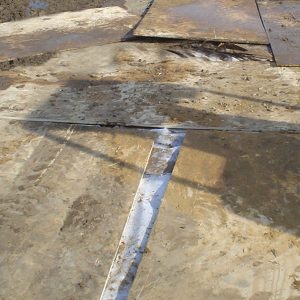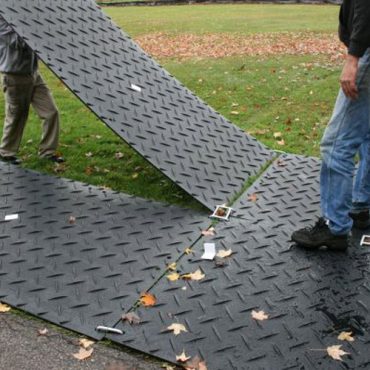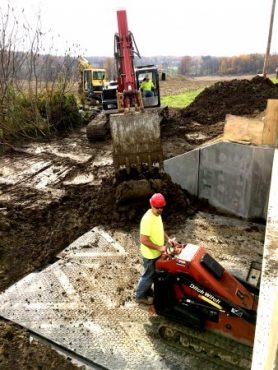
John Bleasby
Ground mats prevent you slip-sliding away!
Canadian ContractorSpring thaw is sloppy time, making safety under foot important
With warmer weather comes the thaw, and with the thaw comes the mud. And mud is slippery underfoot, not only for site workers but for the vehicles and equipment that deliver materials and lift them into position. Often poor ground conditions can prevent trucks or machinery from accessing areas of a site, particularly if the site is sloped or drains poorly. It’s a common habit to throw down sheets of scrap plywood or OSB over the slime and puddles. However, that can result in increased safety hazards — Edges flip up, the boards themselves can shift and break, and there’s always the danger of an old nail or two poking through. Cheap and cheerful, but far from ideal!

Throwing sheets of plywood down around a muddy site fails to address safety and accessibility
With the development of composite matting materials of all sorts, the plywood and OSB’s solution for high traffic areas is a thing of the past.
Start with safety
There are more reasons than just safety that make composite mats appealing today, but it’s certainly a good place to start. Given the care you take to ensure a safe work site within the foundation areas themselves, it only make sense that the high traffic areas leading to and from the site should be safe for human and vehicular traffic as well. Lost time from injury, an unprofessional visual appearance, even the chance of a lawsuit; these are all good reasons to re-examine how you set up your site.
Using simple sheets of ply or OSB may have been your site pathway solution in the past, but they present hazards of their own. They aren’t very durable, since they absorb moisture and therefore deteriorate through rot and cracking over time. They can absorb contaminants and transmit them to another site, which in some cases can be a sensitive issue. In fact, they aren’t very good at preventing contaminants leaching into the earth either. Unlike composite mats, wood sheeting does not provide reliable traction under foot or under tires. At the end of their short life span, they have to be taken to the dump which is not a great environmental solution.

Matting options include lightweight sections that link together to form pathways or bases
More economical over time
Composite mats appear to be the answer for a great number of reasons. Although more expensive upfront, they last much longer, are more easily transportable, and clean up after use. They are light weight, particularly when compared to wood which absorbs moisture over time. The light weight and ease of transport ultimately means they can save time at both ends of the project.
Many varieties are available
Composite mats come to the construction industry from the oil and gas sector, where environmental sensitivity and ease of transport to remote areas are ongoing challenges. They can be found in one of two general styles; solid, one-piece compression moulded systems, or engineered, hollow matting systems. These mats can often be linked together to form larger areas than just the one sheet, thus allowing pathways for wheeled vehicles and hand carts, as well as high volume foot traffic. Neat, easy to clean, and with traction surfaces, they significantly reduce the risk of slips and falls while reducing mess being transmitted into the site area.

Systems like TuffTrak® XT can accommodate the loading of foot traffic and machinery, providing a solid, safe base.
For example, products like TuffTrak® XT can, according to the company website, can be overlapped to “create a temporary access platform for the work equipment and a sturdy work surface for the on-site team. The mat has a foam-filled core and an overlap connection with Four3™ camlocks to avoid ingress of water and contaminants.” The semi-rigid structure prevents the mat from bending or distorting even with heavy loads on soft ground conditions, and provides a firm, secure, and stable surface for machinery to safely move over them. This overlapping connection system means mud can’t leak or force its way through the mats, helping to keep the working surface clean and safe to work on.
Composite mats are superior to wood sheeting as well when it comes providing a firm base for heavier site machinery like cranes and boom trucks. In fact, there are composite matting solutions covering specific site requirements right up to the largest and most rigorous situations found in construction.
Safe, cost effective, environmentally friendly, and easy to transport, install, remove and clean — composite mats have a place on any work site, large or small.
Got feedback? Make your opinion count by using the comment section below,
or by sending an email to:
JBleasby@canadiancontractor.ca
Follow John on Instagram and on Twitter for notifications about his latest posts

![]()

Leave a Reply